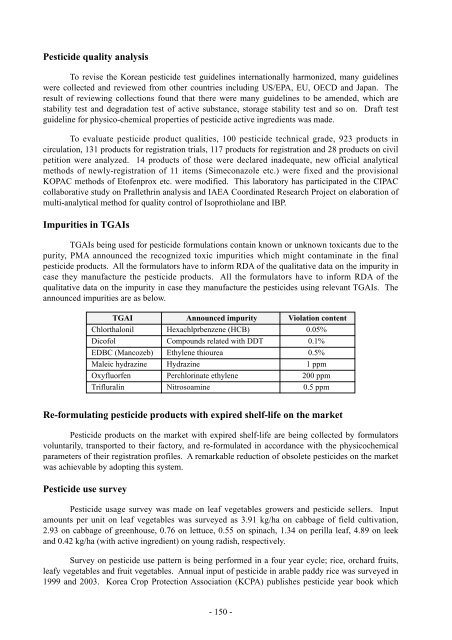Proceedings of the Asia regional workshop on the
Proceedings of the Asia regional workshop on the
Proceedings of the Asia regional workshop on the
Create successful ePaper yourself
Turn your PDF publications into a flip-book with our unique Google optimized e-Paper software.
Pesticide quality analysis<br />
To revise <str<strong>on</strong>g>the</str<strong>on</strong>g> Korean pesticide test guidelines internati<strong>on</strong>ally harm<strong>on</strong>ized, many guidelines<br />
were collected and reviewed from o<str<strong>on</strong>g>the</str<strong>on</strong>g>r countries including US/EPA, EU, OECD and Japan. The<br />
result <str<strong>on</strong>g>of</str<strong>on</strong>g> reviewing collecti<strong>on</strong>s found that <str<strong>on</strong>g>the</str<strong>on</strong>g>re were many guidelines to be amended, which are<br />
stability test and degradati<strong>on</strong> test <str<strong>on</strong>g>of</str<strong>on</strong>g> active substance, storage stability test and so <strong>on</strong>. Draft test<br />
guideline for physico-chemical properties <str<strong>on</strong>g>of</str<strong>on</strong>g> pesticide active ingredients was made.<br />
To evaluate pesticide product qualities, 100 pesticide technical grade, 923 products in<br />
circulati<strong>on</strong>, 131 products for registrati<strong>on</strong> trials, 117 products for registrati<strong>on</strong> and 28 products <strong>on</strong> civil<br />
petiti<strong>on</strong> were analyzed. 14 products <str<strong>on</strong>g>of</str<strong>on</strong>g> those were declared inadequate, new <str<strong>on</strong>g>of</str<strong>on</strong>g>ficial analytical<br />
methods <str<strong>on</strong>g>of</str<strong>on</strong>g> newly-registrati<strong>on</strong> <str<strong>on</strong>g>of</str<strong>on</strong>g> 11 items (Simec<strong>on</strong>azole etc.) were fixed and <str<strong>on</strong>g>the</str<strong>on</strong>g> provisi<strong>on</strong>al<br />
KOPAC methods <str<strong>on</strong>g>of</str<strong>on</strong>g> Et<str<strong>on</strong>g>of</str<strong>on</strong>g>enprox etc. were modified. This laboratory has participated in <str<strong>on</strong>g>the</str<strong>on</strong>g> CIPAC<br />
collaborative study <strong>on</strong> Prallethrin analysis and IAEA Coordinated Research Project <strong>on</strong> elaborati<strong>on</strong> <str<strong>on</strong>g>of</str<strong>on</strong>g><br />
multi-analytical method for quality c<strong>on</strong>trol <str<strong>on</strong>g>of</str<strong>on</strong>g> Isoprothiolane and IBP.<br />
Impurities in TGAIs<br />
TGAIs being used for pesticide formulati<strong>on</strong>s c<strong>on</strong>tain known or unknown toxicants due to <str<strong>on</strong>g>the</str<strong>on</strong>g><br />
purity, PMA announced <str<strong>on</strong>g>the</str<strong>on</strong>g> recognized toxic impurities which might c<strong>on</strong>taminate in <str<strong>on</strong>g>the</str<strong>on</strong>g> final<br />
pesticide products. All <str<strong>on</strong>g>the</str<strong>on</strong>g> formulators have to inform RDA <str<strong>on</strong>g>of</str<strong>on</strong>g> <str<strong>on</strong>g>the</str<strong>on</strong>g> qualitative data <strong>on</strong> <str<strong>on</strong>g>the</str<strong>on</strong>g> impurity in<br />
case <str<strong>on</strong>g>the</str<strong>on</strong>g>y manufacture <str<strong>on</strong>g>the</str<strong>on</strong>g> pesticide products. All <str<strong>on</strong>g>the</str<strong>on</strong>g> formulators have to inform RDA <str<strong>on</strong>g>of</str<strong>on</strong>g> <str<strong>on</strong>g>the</str<strong>on</strong>g><br />
qualitative data <strong>on</strong> <str<strong>on</strong>g>the</str<strong>on</strong>g> impurity in case <str<strong>on</strong>g>the</str<strong>on</strong>g>y manufacture <str<strong>on</strong>g>the</str<strong>on</strong>g> pesticides using relevant TGAIs. The<br />
announced impurities are as below.<br />
TGAI Announced impurity Violati<strong>on</strong> c<strong>on</strong>tent<br />
Chlorthal<strong>on</strong>il Hexachlprbenzene (HCB) 0.05%<br />
Dic<str<strong>on</strong>g>of</str<strong>on</strong>g>ol Compounds related with DDT 0.1%<br />
EDBC (Mancozeb) Ethylene thiourea 0.5%<br />
Maleic hydrazine Hydrazine 1 ppm<br />
Oxyfluorfen Perchlorinate ethylene 200 ppm<br />
Trifluralin Nitrosoamine 0.5 ppm<br />
Re-formulating pesticide products with expired shelf-life <strong>on</strong> <str<strong>on</strong>g>the</str<strong>on</strong>g> market<br />
Pesticide products <strong>on</strong> <str<strong>on</strong>g>the</str<strong>on</strong>g> market with expired shelf-life are being collected by formulators<br />
voluntarily, transported to <str<strong>on</strong>g>the</str<strong>on</strong>g>ir factory, and re-formulated in accordance with <str<strong>on</strong>g>the</str<strong>on</strong>g> physicochemical<br />
parameters <str<strong>on</strong>g>of</str<strong>on</strong>g> <str<strong>on</strong>g>the</str<strong>on</strong>g>ir registrati<strong>on</strong> pr<str<strong>on</strong>g>of</str<strong>on</strong>g>iles. A remarkable reducti<strong>on</strong> <str<strong>on</strong>g>of</str<strong>on</strong>g> obsolete pesticides <strong>on</strong> <str<strong>on</strong>g>the</str<strong>on</strong>g> market<br />
was achievable by adopting this system.<br />
Pesticide use survey<br />
Pesticide usage survey was made <strong>on</strong> leaf vegetables growers and pesticide sellers. Input<br />
amounts per unit <strong>on</strong> leaf vegetables was surveyed as 3.91 kg/ha <strong>on</strong> cabbage <str<strong>on</strong>g>of</str<strong>on</strong>g> field cultivati<strong>on</strong>,<br />
2.93 <strong>on</strong> cabbage <str<strong>on</strong>g>of</str<strong>on</strong>g> greenhouse, 0.76 <strong>on</strong> lettuce, 0.55 <strong>on</strong> spinach, 1.34 <strong>on</strong> perilla leaf, 4.89 <strong>on</strong> leek<br />
and 0.42 kg/ha (with active ingredient) <strong>on</strong> young radish, respectively.<br />
Survey <strong>on</strong> pesticide use pattern is being performed in a four year cycle; rice, orchard fruits,<br />
leafy vegetables and fruit vegetables. Annual input <str<strong>on</strong>g>of</str<strong>on</strong>g> pesticide in arable paddy rice was surveyed in<br />
1999 and 2003. Korea Crop Protecti<strong>on</strong> Associati<strong>on</strong> (KCPA) publishes pesticide year book which<br />
- 150 -

















